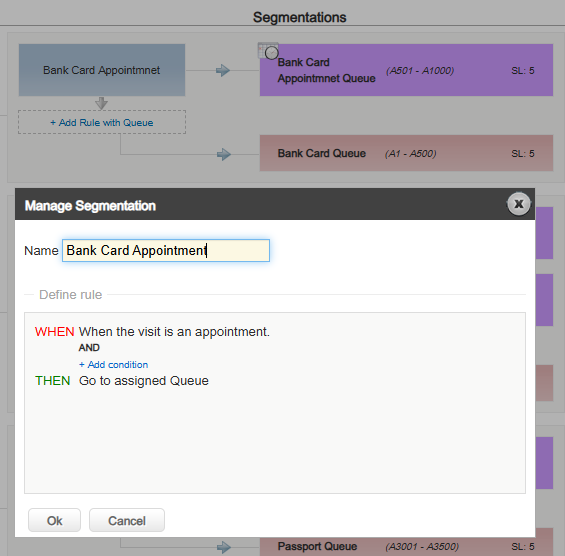Working with segmentation rules
In some cases, you want to treat or serve your customers differently, depending on for example if they have an appointment or not, or if they speak different languages. The system can then segregate the customers by placing them in different queues. By using different queues and number series, customers are more likely to experience the waiting as fair. The segmentation can be based on the following variables:
Service (segmented already in the service groups)
Properties of the visit or customer (For example VIP Level or language).
Type of visit (appointment or walk-in visit)
How late or early the customer is for an appointment
The segmentation rules are setup as part of the queuing profile, which in turn is a part of the operation profile. When you create a segmentation rule, a queue is automatically created. A common segmentation rule would be the following:
WHEN the visit is an appointment, THEN go to the assigned queue.

If you have an AND condition in your segmentation rule, both statements must be true for the visit to end up in the assigned queue. If you have more than one segmentation rule for a group of services, the rules are evaluated in the order they are entered. Once a segmentation rule is true, the queue selection is finished and the rest of the segmentation rules are not evaluated.
The following segmentation rules are available:
Segmentation rule | Possible values | Example |
|---|---|---|
When the language code in the visit is set to <set value> | Language codes from the languages set up in General Admin | When the language code in the visit is set to de_DE. |
Where the gender in the visit is set to <set value>. | Female Male | Where the gender in the visit is set to Female |
Where the VIP level in the visit is one of the levels <set value> | VIP Level 1 VIP Level 2 VIP Level 3 | Where the VIP level in the visit is one of the levels VIP Level 1. |
When the visit is an appointment. | ||
When the appointment is <set value> by over <set value> minutes. | Early Late + number of minutes | When the appointment is late by over 30 minutes. |
When the appointment is <set value> no more than <set value> minutes. | Early Late + number of minutes | When the appointment is early no more than 10 minutes. |